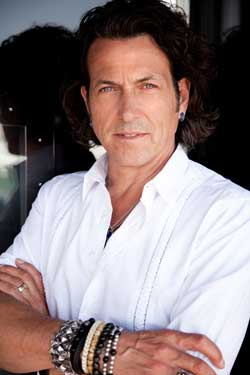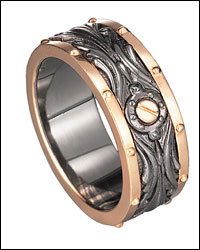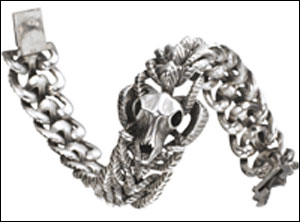|
MALE BLING THE NATURAL THING
This is the dawning of the age of decoration – for men, that is. Some older reactionaries may find this an effeminate sign of the times but they are the ones out of step. As jewellery designer, Stephen Webster, made plain in a recent speech, jewellery or adornments have been with us since the cave men, and recent rejection of such has been an aberration.
In an entertaining romp through the ages, Webster, one of the UK’s most successful jewellers, covered archeological  digs and Sutton Hoo treasures, Tudor bling and Royal extravagances through to Beau Brummell’s influence and the excesses of military decorations, including the diamond encrusted garter – “a strange thing to award men for bravery”. digs and Sutton Hoo treasures, Tudor bling and Royal extravagances through to Beau Brummell’s influence and the excesses of military decorations, including the diamond encrusted garter – “a strange thing to award men for bravery”.
Speaking at the London Jeweller Fair, he heralded the new age of men’s jewellery with an assessment of how it disappeared and why it has come back.
“Scientists have been able to prove the exact time when man completely
destroyed centuries of successful accessorizing; 3pm October 19th 1982,” he told an audience of designers, retailers and buyers.
“Tottenham v Chelsea. Footballers started wearing jewellery. Some people blame the influx of southern Europeans infiltrating the English football league, bringing with them fancy dribbling skills, the professional dive but most of all gold. Loads of it.
“Apparently by mid season there was enough thick gold rope chain amongst
the top flight teams to hang the entire England squad. Even though without a
 doubt the Europeans probably introduced this ghastly fashion, I personally lay a doubt the Europeans probably introduced this ghastly fashion, I personally lay a
lot of the blame on the home grown duo of Glenn Hoddle and Chris Waddle, and
quite possibly Kevin Keegan. The stigma was such that at the mere mention of
the word medallion or sovereign ring men would run a mile. Even the historic
gold Souk of Wembley market was on its knees, offering half price men's gold for
a decade.”
Top, Stephen Webster showing his own penchant for decoration. Above, one of his latest ring designs, the chunky gold Spinning ring; below, a silver bracelet with ramshead detail, a current favourite with customers.
Fast forward nearly twenty years, and he decided the time was ripe to launch a Stephen Webster men’s collection. With typical chutzpah, he acknowledged he was wrong, this was a failure.
“ The press loved it,” he said, “but with the exception of Neiman Marcus in
the States who had a small but consistent men's business, no-one else wanted to
take it up.
"Such was the lack of confidence for men's jewellery amongst the retail
community that apart from the cufflink selection, maybe some pens and a couple
of signet ring blanks, there wasn't even a place to display a men's collection.”
But happily the watch business helped change that. As watch brands proliferated and watch collecting brought men  into jewellery shops, so the shops started to think about stocking some men’s jewellery. into jewellery shops, so the shops started to think about stocking some men’s jewellery.
“This was the beginning of the most recent revival of men’s jewellery and accessories. The big story really is one of male grooming. Men were starting to do things they had never done before such as deodorize, moisturize, wax and even help with the washing up. This was considered by modern day Darwinians to be the most significant leap forward since hunter gatherers stopped masturbating in public.”
Now, men’s sales account for some 15% of Webster’s business, compared with 5% just five or six years back. He reports that his customers’ appreciation of and desire for jewellery has come on in leaps and bounds, with an interest in design and a taste for “manly” materials and stones – such as flint, bloodstone and black diamonds.
He concluded by forecasting that the men’s jewellery market will continue to grow, with more designers producing more diverse products.
“Men have once again learned how to accessorize.”
See www.stephenwebster.com
|